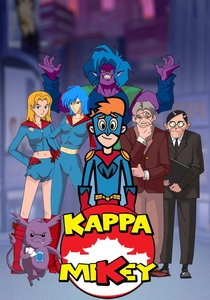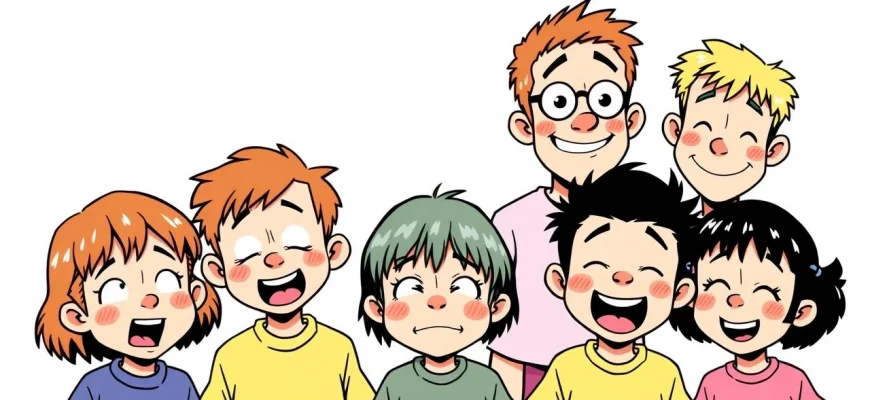If you're a fan of the classic anime 'Osomatsu-kun' (1966) and its quirky humor, you're in for a treat! This article explores 10 movies and shows that capture the same zany energy, sibling dynamics, and comedic charm. Whether you're looking for nostalgic throwbacks or modern takes on similar themes, this list has something for every fan of the original series.

Cromartie High School (2003)
Description: Cromartie High School and Osomatsu-kun (1966) both feature a cast of quirky characters who engage in bizarre and humorous antics. The deadpan delivery of absurd situations in Cromartie High School is similar to the comedic timing in Osomatsu-kun. Both shows also have a satirical edge, poking fun at societal norms and stereotypes. The minimalist animation style in Cromartie High School allows the humor to shine, much like the straightforward yet effective animation in Osomatsu-kun.
Fact: The series is based on a manga by Eiji Nonaka. The anime features a robot student named Mechazawa, who is treated as a normal student by his classmates. Freddie Mercury, the lead singer of Queen, is a recurring character in the series.
 Watch Now
Watch Now 
Wasteful Days of High School Girls (2019)
Description: Wasteful Days of High School Girls shares Osomatsu-kun's (1966) focus on the humorous and often ridiculous aspects of daily life. Both shows feature a tight-knit group of friends who engage in silly and exaggerated antics. The humor in both series is character-driven, with each member of the group contributing to the comedic dynamic. The lighthearted and nostalgic tone of Wasteful Days of High School Girls is similar to the charm of Osomatsu-kun.
Fact: The series is based on a manga by Binzo. The anime was produced by Passione, known for 'Hinamatsuri' and 'Rokka: Braves of the Six Flowers'. The show's title refers to the idea that the girls' high school days are 'wasteful' in the sense that they are carefree and full of fun.
 Watch Now
Watch Now 
Arakawa Under the Bridge (2010)
Description: Arakawa Under the Bridge and Osomatsu-kun (1966) both revolve around a group of eccentric characters living in unconventional settings. The humor in both series stems from the oddball interactions between the characters and their surreal environments. Arakawa Under the Bridge's whimsical and offbeat tone is reminiscent of the playful absurdity found in Osomatsu-kun. Both shows also explore themes of community and belonging in their own unique ways.
Fact: The series is based on a manga by Hikaru Nakamura. The anime was produced by Shaft, known for their distinctive visual style. The protagonist, Kou Ichinomiya, has a strict policy of never being indebted to anyone, which leads to his life under the bridge.
 Watch Now
Watch Now 
Daily Lives of High School Boys (2012)
Description: Daily Lives of High School Boys is similar to Osomatsu-kun (1966) in its episodic and comedic portrayal of a group of male friends. Both shows excel in capturing the absurdity and humor of everyday life, with a focus on the dynamics between the characters. The humor in both series is often surreal and exaggerated, making them highly entertaining. Additionally, both shows have a nostalgic charm that appeals to audiences of all ages.
Fact: The series is based on a manga by Yasunobu Yamauchi. It was produced by Sunrise, the same studio behind popular anime like 'Cowboy Bebop' and 'Gundam'. The show's opening theme, 'Shiny Tale', was performed by Mix Speakers, Inc., a band formed specifically for the anime.
 Watch Now
Watch Now 
Space Dandy (2014)
Description: Space Dandy and Osomatsu-kun (1966) share a love for over-the-top, episodic adventures filled with humor and heart. Both shows feature a group of misfit characters who navigate absurd and often surreal situations. The visual style of Space Dandy, with its vibrant colors and dynamic animation, echoes the energetic and playful aesthetic of Osomatsu-kun. Additionally, both series have a knack for blending comedy with moments of unexpected depth.
Fact: Space Dandy was directed by Shinichiro Watanabe, known for 'Cowboy Bebop' and 'Samurai Champloo'. Each episode was produced by a different team of animators, resulting in a variety of visual styles. The show's soundtrack was composed by various artists, including the band 'The Seatbelts'.
 Watch Now
Watch Now 
Pop Team Epic (2018)
Description: Pop Team Epic shares Osomatsu-kun's (1966) irreverent and chaotic humor. Both shows are known for their rapid-fire jokes, absurd scenarios, and breaking the fourth wall. The animation style in Pop Team Epic, which often changes and parodies other anime, is reminiscent of the visual gags and stylistic experimentation in Osomatsu-kun. Both series thrive on their unpredictability and willingness to push the boundaries of comedy.
Fact: Pop Team Epic is based on a four-panel manga by Bkub Okawa. Each episode is essentially shown twice, with different voice actors for the second half. The show is famous for its meme-worthy moments and references to internet culture.
 Watch Now
Watch Now 
Kappa Mikey (2006)
Description: Kappa Mikey shares similarities with Osomatsu-kun (1966) in its comedic and absurdist approach to storytelling. Both shows feature a group of eccentric characters who often find themselves in ridiculous situations. The humor in both series is fast-paced and relies heavily on visual gags and slapstick comedy, which is a hallmark of Osomatsu-kun. Additionally, Kappa Mikey's blend of American and Japanese animation styles mirrors the cultural fusion often seen in Osomatsu-kun.
Fact: Kappa Mikey was the first original animated series produced by Nickelodeon's animation studio in New York. The show was created by Larry Schwarz, who also worked on other animated series like 'The Adventures of Chico and Guapo'. The name 'Kappa Mikey' is a play on words, combining 'kappa' (a mythical Japanese creature) and 'Mikey' (a common American name).
 Watch Now
Watch Now 
Chibi Maruko-chan (1990)
Description: Chibi Maruko-chan and Osomatsu-kun (1966) both offer a nostalgic and humorous look at childhood. While Chibi Maruko-chan focuses on a young girl and her family, the show's slice-of-life humor and heartwarming moments are reminiscent of the familial and comedic elements in Osomatsu-kun. Both series capture the simplicity and charm of everyday life, making them enduring favorites.
Fact: Chibi Maruko-chan is based on a semi-autobiographical manga by Momoko Sakura. The anime is known for its distinctive art style and catchy theme songs. The series has been adapted into live-action dramas and stage plays.
 30 Days Free
30 Days Free 
Doraemon (1979)
Description: Doraemon and Osomatsu-kun (1966) are both classic anime that have left a lasting impact on Japanese pop culture. While Doraemon is more family-friendly, both shows share a sense of whimsy and adventure. The episodic nature of Doraemon, with its focus on the misadventures of Nobita and his friends, is similar to the comedic vignettes in Osomatsu-kun. Both series also use humor to explore themes of friendship and personal growth.
Fact: Doraemon is one of the most iconic and longest-running anime in Japan. The character Doraemon is a robotic cat from the 22nd century sent back in time to help Nobita. The series has spawned numerous movies, spin-offs, and even a CGI remake.
 30 Days Free
30 Days Free 
Ninja Hattori-kun (1981)
Description: Ninja Hattori-kun and Osomatsu-kun (1966) share a playful and lighthearted approach to comedy. Both shows feature a group of characters who get into humorous and often surreal situations. The dynamic between Hattori and his friends is similar to the camaraderie and antics of the Matsuno brothers in Osomatsu-kun. The shows also share a timeless appeal, making them enjoyable for audiences of all ages.
Fact: Ninja Hattori-kun is based on a manga by Fujiko Fujio, the duo behind 'Doraemon'. The anime was popular in India, where it was dubbed in Hindi and aired on Cartoon Network. The series features a mix of traditional ninja skills and modern-day humor.
 30 Days Free
30 Days Free 








